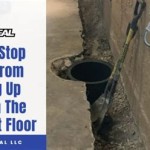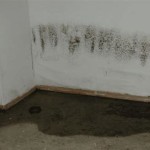How to Fix a Water Leak in a Basement Floor
A water leak in a basement can cause significant damage to your home, leading to mold growth, structural issues, and even health problems. It's crucial to address the leak promptly and effectively. This article will guide you through the process of fixing a water leak in your basement floor, offering practical steps and essential information.
Step 1: Identify the Source of the Leak
The first and most important step is to pinpoint the source of the leak. This might involve examining the following:
- Exterior Drainage: Look for clogged gutters, downspouts directing water towards the foundation, or inadequate grading around the house leading to water pooling near the foundation.
- Interior Plumbing: Check for leaks in pipes, fixtures, and appliances within the basement. Investigate any visible signs of moisture, corrosion, or dripping.
- Foundation Cracks: Inspect the foundation walls for cracks, especially around windows and doors. These cracks could allow water to seep into the basement.
- Window and Door Seals: Examine the seals around basement windows and doors for any gaps or damage that could permit water entry.
Once you've identified the source, you can proceed to the next step.
Step 2: Stop the Water Flow
After identifying the source of the leak, the next step is to stop the water flow. This will prevent further damage and make it easier to address the underlying issue. You can achieve this by:
- Turning off the Water Supply: If the leak originates from plumbing, turn off the main water valve to the house or the specific valve supplying the leaking fixture or appliance.
- Repairing Damaged Plumbing: If you find a leaky pipe or fixture, you might be able to temporarily fix it with a clamp or pipe sealant. However, it's best to call a professional plumber for a permanent solution.
- Redirecting Water Flow: If the leak is due to exterior drainage issues, you can redirect the water flow away from the foundation by cleaning gutters, extending downspouts, or improving the grading around the house.
Once the water flow has stopped, you can address the damaged areas.
Step 3: Dry the Basement Floor
Water damage to your basement floor requires proper drying to prevent mold growth and structural issues. You can utilize a combination of methods, including:
- Air Circulation: Open windows and doors to allow fresh air to circulate and naturally dry the area. You can also use fans to improve ventilation.
- Dehumidifiers: A dehumidifier effectively removes moisture from the air, accelerating the drying process. Place the dehumidifier in the basement and ensure it's large enough for the space.
- Commercial Drying Equipment: For severe water damage, professional drying equipment like air movers and desiccant dehumidifiers is necessary to remove moisture quickly and prevent mold growth. These machines are typically rented or used by professional restoration companies.
It's important to ensure the basement floor is completely dry before proceeding with further repairs.
Step 4: Repair the Damaged Floor
Once the basement floor is dry, you can address any damage caused by the leak. The repair process will depend on the extent of the damage and the type of flooring material.
- Concrete Floor: Cracks in a concrete floor can be repaired using epoxy or polyurethane crack filler. However, for extensive damage, you may need to replace sections of the concrete floor.
- Tile Floor: Loose or cracked tiles need to be replaced. If the water damage affected the subfloor, it must be repaired or replaced before reinstalling the tiles.
- Wood Floor: Water damage to wood floors can cause warping, buckling, or rot. Damaged planks need to be replaced, and the subfloor should be inspected for moisture.
The extent of repairs may require the expertise of a professional contractor.
Step 5: Prevent Future Leaks
After addressing the current leak, it's crucial to take proactive measures to prevent future leaks. These measures include:
- Regular Maintenance: Inspect your basement regularly for signs of leaks or water damage. This includes checking gutters, downspouts, plumbing fixtures, and foundation walls for any issues.
- Improve Drainage: Ensure proper grading around the house to direct water away from the foundation. Clean gutters and downspouts regularly to prevent clogs.
- Seal Cracks and Gaps: Repair any cracks in the foundation walls using appropriate sealant. Seal gaps around windows and doors to prevent water entry.
- Consider a Sump Pump: A sump pump can help remove water that collects in the basement, especially if you have a high water table or experience heavy rainfall.
By taking these preventative steps, you can significantly reduce the risk of future basement leaks and protect your home from water damage.

What Causes Leaky Floors In Basements Fixing Leaking Basement

What Causes Leaky Floors In Basements Fixing Leaking Basement

Water Coming Up From Basement Floor Where Is The Leak How To Stop It

The Best Methods For Basement Leak Repair Acculevel

Wet Basement Diy Repair Guide Radonseal

Help My Basement Leaks When It Rains News And Events For Systems Inc

Get To Know How A Leaky Basement Can Ruin Your Home

Finding And Fixing Basement Leaks How To Waterproof Your

7 Reasons Water Is Seeping Through Your Basement Floor

Where And Why Do Basements Leak What Causes Basement Leaking
Related Posts







